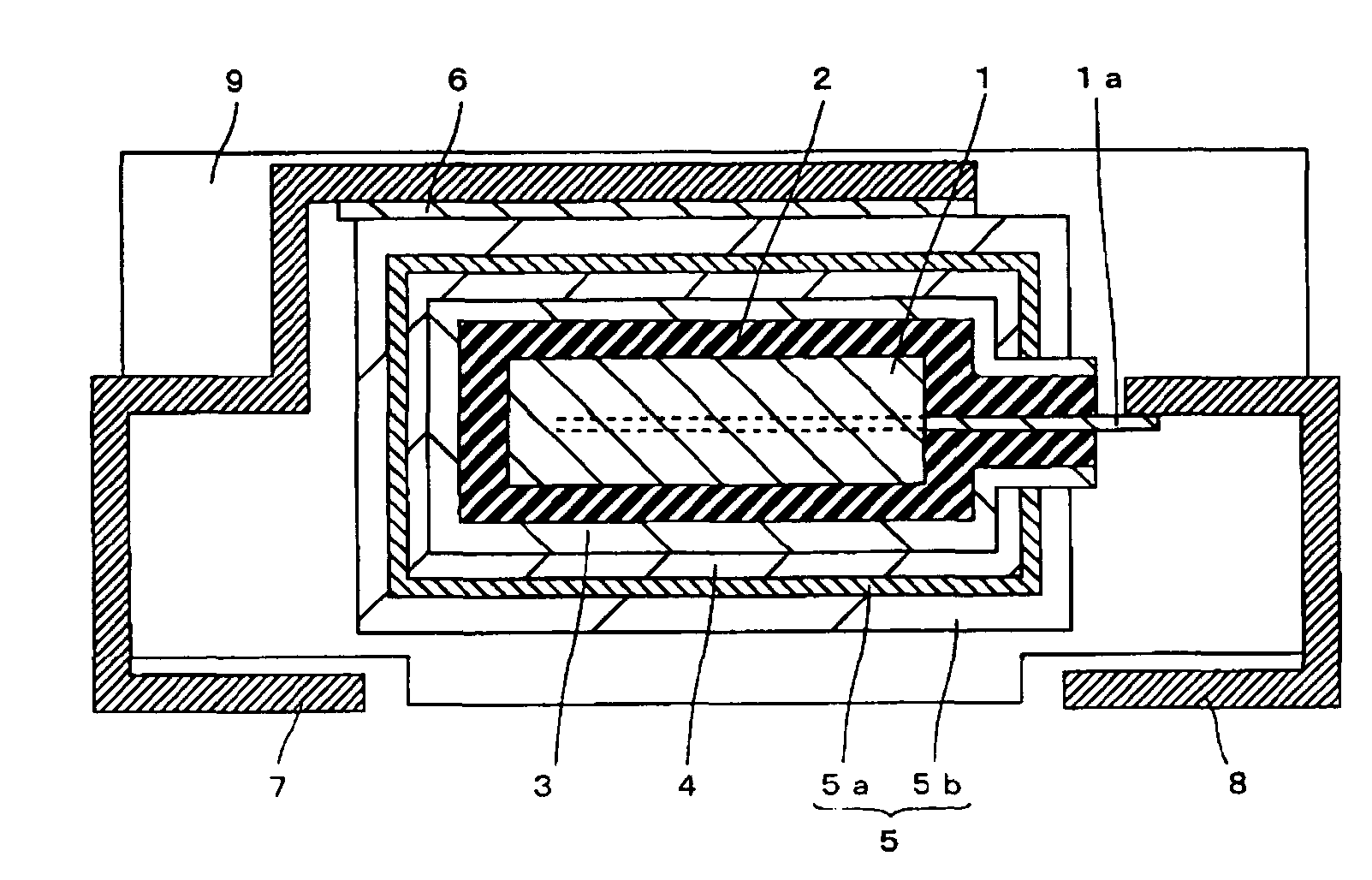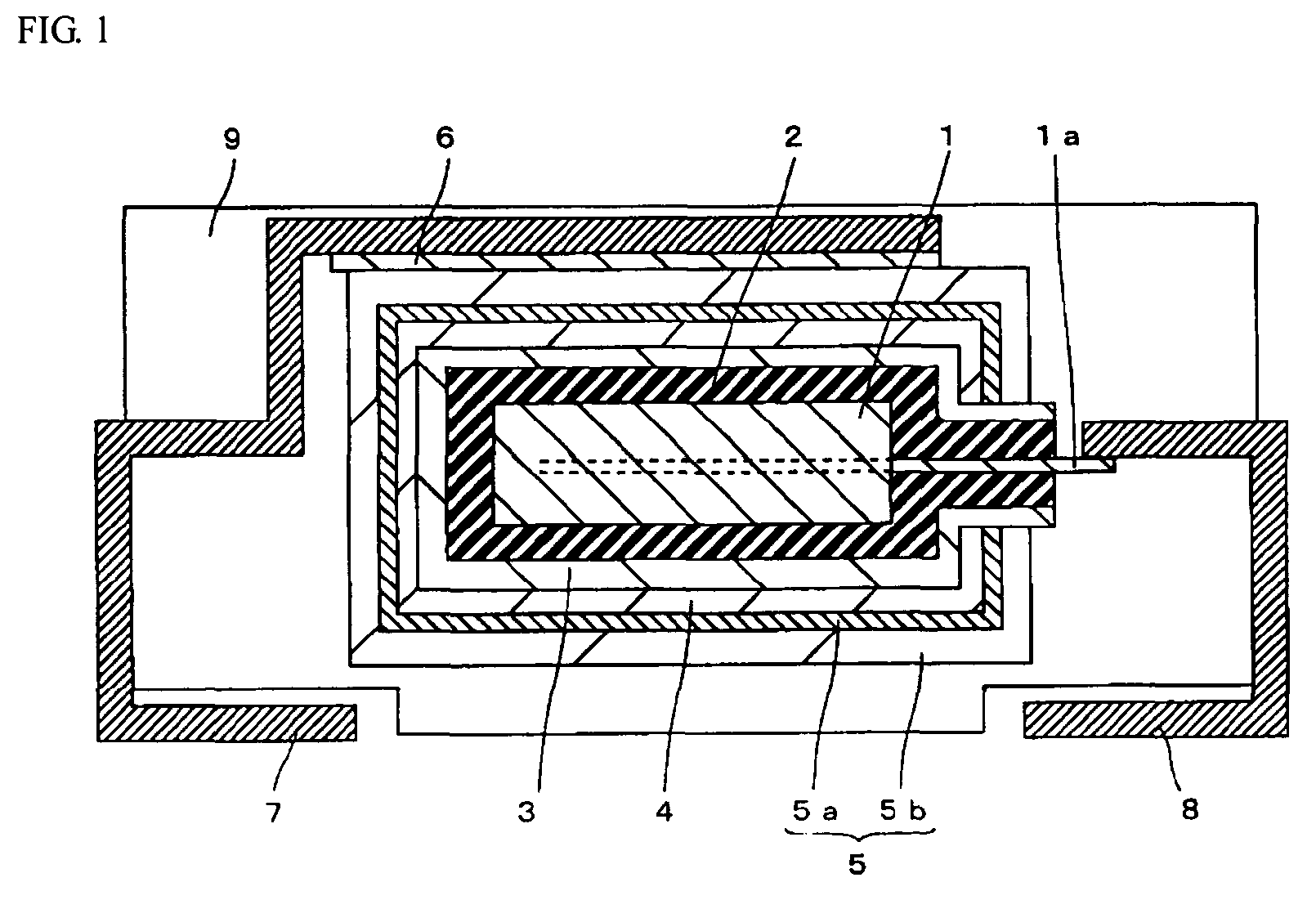Solid electrolytic capacitor and manufacturing method thereof
a technology of electrolyte capacitor and solid electrolytic capacitor, which is applied in the direction of variable capacitor, fixed capacitor, fixed capacitor details, etc., can solve the problem of not getting sufficient esr, achieve good adhesion property to carbon, improve the adhesion property and reduce the contact resistance between the electrolyte layer and the cathode
- Summary
- Abstract
- Description
- Claims
- Application Information
AI Technical Summary
Benefits of technology
Problems solved by technology
Method used
Image
Examples
example 1
[0025]A structure of a solid electrolytic capacitor according to example 1 of the present invention is now described with reference to FIG. 1.
[0026]First, in the solid electrolytic capacitor according to example 1 of the present invention, a plate-shaped anode 1 is formed for covering the one part of an anode lead 1a of tantalum, as shown in FIG. 1. The anode 1 has a porous sintered body of tantalum prepared by sintering tantalum particles having an average particle diameter of about 2 μm in a vacuum. Tantalum is an example of the “metal” forming the anode in the present invention.
[0027]A dielectric layer 2 of tantalum oxide is formed for covering the anode 1. An electrolyte layer 3 of polypyrrole is formed for covering the dielectric layer 2.
[0028]An intermediate layer 4 of aminopropyltriethoxysilane (APTES) having a thickness of an approximately monomolecular layer (about 0.5 nm) is formed uniformly for covering the electrolyte layer 3. APTES is an example of “organic silane” in t...
example 2
[0047]In example 2, solid electrolytic capacitors having the same structure as that in example 1 are fabricated except that an intermediate layer 4 of another organic silane is formed instead of the intermediate layer 4 of APTES in the aforementioned example 1.
[0048]In this example, the solid electrolytic capacitors are fabricated in the same manner as in example 1, except that aqueous solutions are formed of about 0.002 wt % of octadecyltriethoxysilane (OTES), n-propyltrichlorosilane (nPTCS), dimethoxydiphenylsilane (DMDPS), methylphenyidichlorosilane (MPDCS) and mercaptopropyltrimethoxysilane (MPTMS) respectively, instead of the aqueous solution containing about 0.002 wt % of APTES used in example 1. Thus, the solid electrolytic capacitors having the intermediate layer 4 of OTES, nPTCS, DMDPS, MPDCS and MPTMS with a thickness of an approximately monomolecular layer (about 0.1 nm to about 2.0 nm) disposed between the electrolyte layer 3 and the cathode 5 are fabricated respectively...
PUM
| Property | Measurement | Unit |
|---|---|---|
| thickness | aaaaa | aaaaa |
| particle diameter | aaaaa | aaaaa |
| thickness | aaaaa | aaaaa |
Abstract
Description
Claims
Application Information
 Login to View More
Login to View More - R&D
- Intellectual Property
- Life Sciences
- Materials
- Tech Scout
- Unparalleled Data Quality
- Higher Quality Content
- 60% Fewer Hallucinations
Browse by: Latest US Patents, China's latest patents, Technical Efficacy Thesaurus, Application Domain, Technology Topic, Popular Technical Reports.
© 2025 PatSnap. All rights reserved.Legal|Privacy policy|Modern Slavery Act Transparency Statement|Sitemap|About US| Contact US: help@patsnap.com


